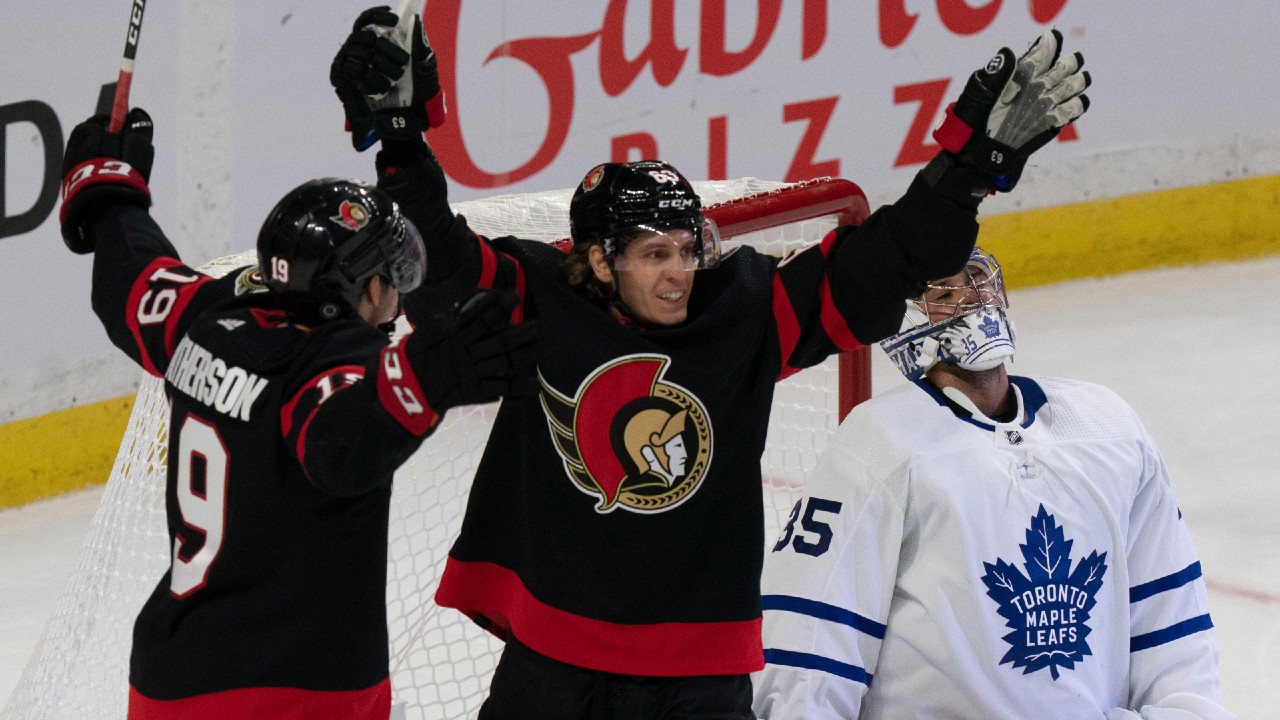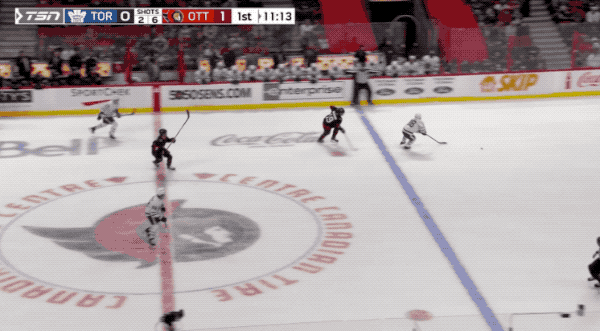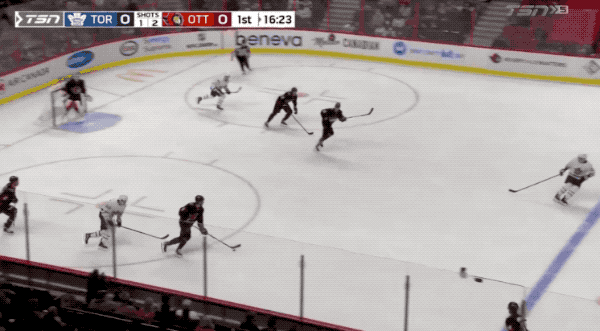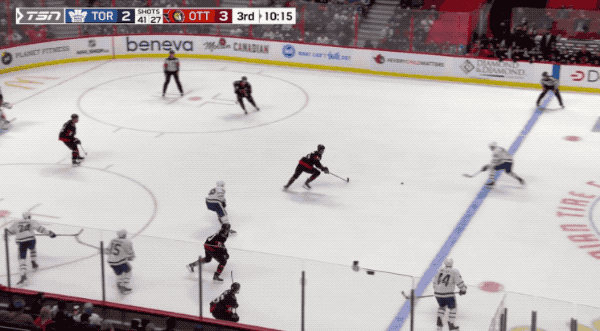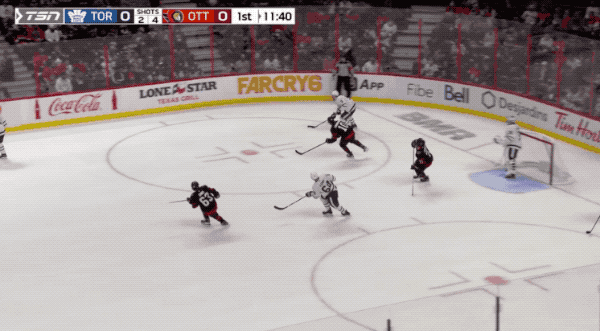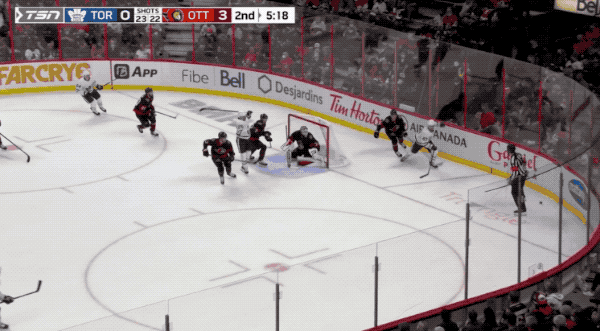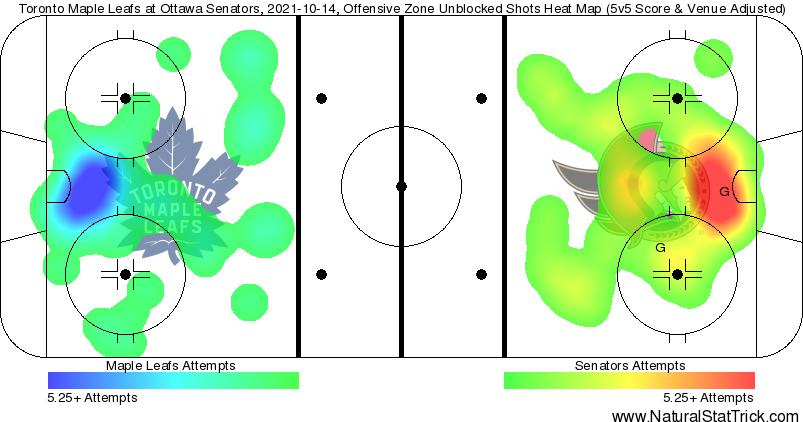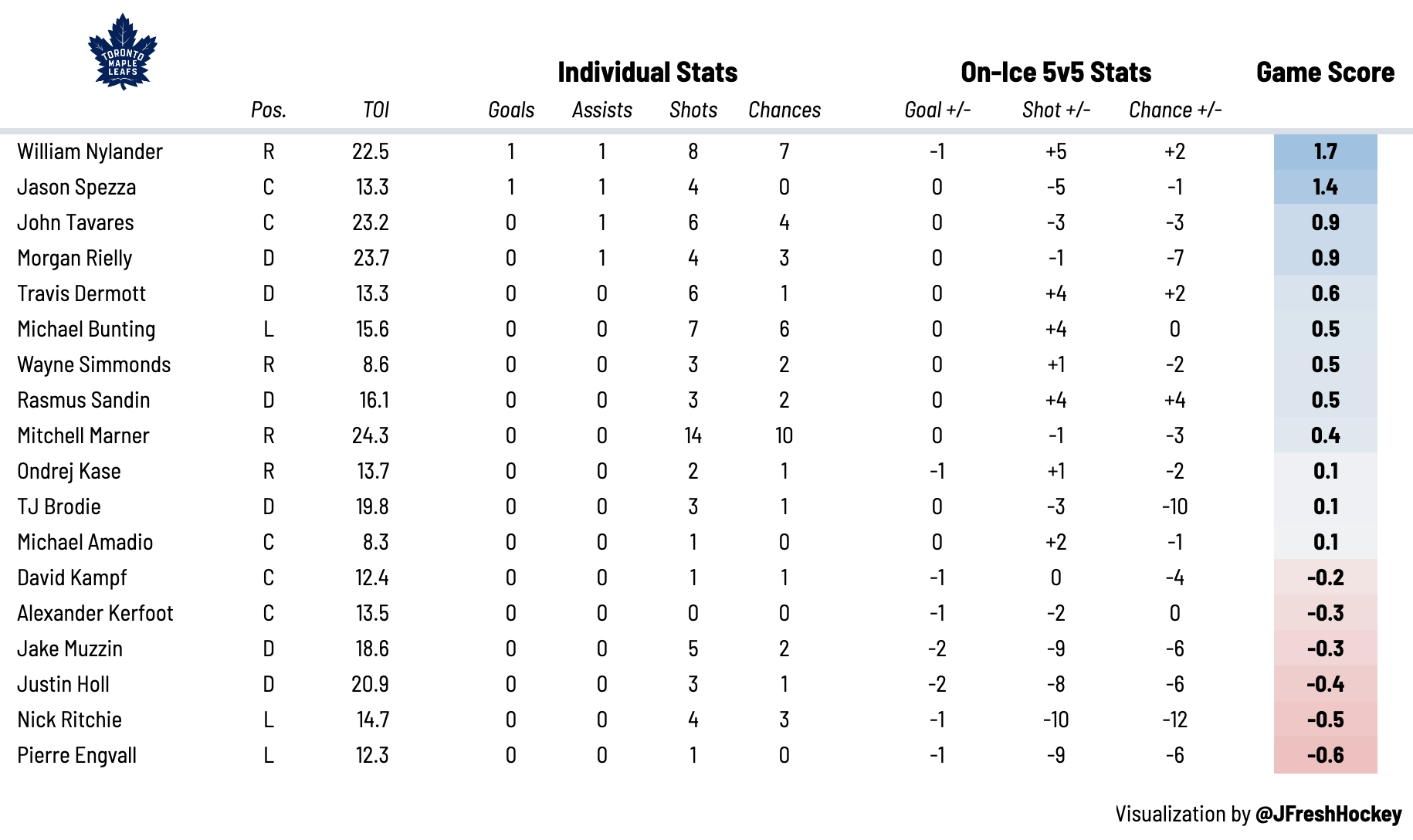Well, that was certainly a hockey game.
I’m still trying to process what on earth I just watched. Let’s walk through it period by period to get a better understanding of things here.
- 1st Period: The Leafs trailed in shot attempts but dominated in expected Goals and high-danger chances (particularly as the period wore on), and somehow got out-scored 3-0 by Ottawa.
- 2nd Period: The Leafs were dominated in all statistical categories, and the score somehow remained 3-0.
- 3rd Period: The Leafs dominated, scored twice to make it 3-2, and ultimately fell short.
That comeback falls largely on the shoulders of Jason Spezza, who we’ll be breaking down in more detail shortly. The more troublesome takeaway for me is that he needed to be the one to spark it after things weren’t going the Leafs‘ way, which seems to happen a lot when things tighten up for Toronto.
To top things off, Petr Mrazek left the game after two periods with a groin injury and did not return. Just in case you were wondering if there was any reason for optimism in this game, there wasn’t much.
Let’s evaluate each Leaf individually to help explain why, starting with the few guys who actually did make a meaningful impact tonight.
5 Stars
Jason Spezza (RW, #19) — Watching him quarterback PP1 makes me wonder what could have been last year. He’s still excellent at threading passes through the seam, pulling it off twice at 5-on-4 to William Nylander and another time to Morgan Rielly as time expired. He only picked up an assist on one of those plays, but those are extremely high-value passes that are going to lead to a lot of goals.
Spezza also let a bomb go from the top of the right circle, beating Anton Forsberg clean, which wasn’t an easy task tonight. There is an element of frustration when I see Spezza make these high-end offensive plays with consistency, knowing he’ll be stuck on the fourth line with linemates who can’t do anything with the cross-ice passes he feeds them.
Now seems like a good time to bring up the fact that Joe Thornton got PP1 usage in the playoffs over Spezza last season. I’m not sure why the Leafs have insisted on playing Spezza so few minutes when he’s proven he can produce at an elite rate, but it’s nice to see them use him on PP1 to start the year in Matthews’ absence.
4 Stars
William Nylander (RW, #88) — We’re only two games into the season, but Nylander appears to be picking things up where they left off in the playoffs. He’s been flying up and down the ice in transition, gaining the zone with speed, and making high-skill plays with the puck to create quality scoring opportunities.
What’s impressed me the most early on is how much he’s generating individually by way of his shot. He finished the game with seven shots from the slot, one of which found the back of the net. Whether he’s teeing up from the dots on the power play or getting himself open at the net front off the cycle at even strength, it’s clear that he’s generating offense at an elite rate.
He also played over 22 minutes tonight, so it’s nice to know his stellar play is finally being rewarded by the coaching staff.
Michael Bunting (LW, #58) — We should start a running tally of how often Bunting gets knocked down after going hard to the net. He was making a lot of friends in the blue paint again tonight, frustrating opposing defenders enough to eventually draw an interference penalty later in the game.
Bunting also had a few good scoring chances in this game, including a breakaway, a few good whacks at some rebounds in tight, and a one-timer coming off of a Rasmus Sandin seam pass. I’m not sure how that last one stayed out.
Sometimes you just have to throw your hands up and shout “goalies!”
Petr Mrazek (G, #34) — Speaking of goalies, Mrazek played excellent in the second period to help keep Toronto in the game. I’m sure Goalie Twitter has had their arguments about every goal he allowed in this game, but if you go back and rewatch each one, *insert Steve Briere voice* there actually wasn’t much he could do.
- Goal 1: Rebound, backdoor pass
- Goal 2: Redirection off Tyler Ennis’ knee
- Goal 3: Redirection off Justin Holl
Hockey’s a random sport, so these things are going to happen. I just don’t love blaming goalies for every goal that crosses the goal line. Mrazek followed up that unlucky first period with a spectacular second period, making toe saves and bailing out the overly aggressive PK when Ottawa quickly reversed play to the weak side.
It’s really too bad about that groin injury.
Goaltender Petr Mrázek will not return to tonight’s game due to injury (groin).
— Leafs PR (@LeafsPR) October 15, 2021
I would’ve thought it was his collarbone that was bothering him after a puck caught him awkwardly up high, but this is much more concerning for a goaltender who’s had injury concerns in the past.
Jack Campbell (G, #36) — Mrazek’s replacement held down the fort in the third period, coming up with a few big saves when the game turned into pond hockey. The Leafs and Sens were trading chances late, with Campbell providing some stability in net to help Toronto try to climb back.
3 Stars
Rasmus Sandin (LW, #38) — His pass to Bunting was ridiculous; everyone in the building thought Sandin was shooting before he looked off the defense and slid the puck over to Bunting for the cross-seam one-timer. He’s such a clever passer, a trait that also came in handy on the breakout for Toronto this evening.
Patience at one end of the ice leads to a quality opportunity at the other end. It’s all about opening up space for your teammates.
Mitch Marner (RW, #16) — I’m not sure what Mitch Marner will have to do this season to have the majority of fans agree he played well, but apparently 10 shots from the slot in a losing effort to Ottawa isn’t enough. Call me crazy, but I like it when skilled players get themselves to good areas on the ice and generate shots from dangerous locations.
I’m well aware that none of those pucks went in, but good things happen when you generate chances with consistency. Marner deserved a goal tonight when you look at his shot volume and the quality of those opportunities. As we know too well as Leafs fans, though, the Hockey Gods don’t give a damn about that. Neither do the Shooting Percentage Gods.
With respect to his play on the power play, I liked his ability to create chances from the middle of the ice once the Leafs were set up in-zone. However, he was a big part of the reason they struggled to gain the zone. The best NHL power plays drop it do their zone entries wizards; Connor McDavid, Nathan Mackinnon, etc. The Leafs have let Marner run the majority of those entries, so when he fails to gain the zone, that’s on him — no one else.
David Kampf (C, #64) — He was stripping a lot of pucks in this game, especially in the offensive zone to regain possession. Now, his ability to create anything dangerous off of those turnovers is a bit limited, but it’s still a valuable trait in a defensive center.
Check out how he only needed one hand to get the puck back on this play.
There wasn’t another play available afterward, so he just whipped it around the boards and ended his shift. I can see why a coaching staff would value this type of player — you know exactly what to expect every time he’s on the ice.
Not much is going to happen, and that’s okay. It’s literally his job to make nothing happen.
My boys, Ondrej Kase and Travis Dermott — It wasn’t Kase’s best game, although he did help transition the puck up the ice for Toronto’s third line, which wasn’t as nearly as strong tonight. More importantly, I’d like to discuss the development of Dermott’s offensive game. He’s activating much deeper into the zone on the forecheck, which has allowed him to make plays with the puck in more dangerous areas of the ice.
He’s no Sandin or Rielly, but he looks much more dynamic in the offensive zone than I’ve ever seen him. By now, I’m sure all of my regular readers know that Dermott can shed the first forechecker on the breakout and take away space in the neutral zone defensively. Strangely enough, the biggest hurdle for him at 5v5 has been the offensive zone. He finally appears to be building some confidence in that area of the rink, which is only going to improve his value moving forward.
2 Stars
The Rielly-Brodie Pair — This feels disingenuous to Morgan Rielly, who was clearly the superior defenseman in this game for my money. Then again, when your pair gets drastically out-chanced at even strength, you have to shoulder some of the responsibility. Rielly was great at activating into the play off the rush and extending OZ sequences by essentially playing left wing to keep the puck deep, but he also got beat behind for a few quality rush opportunities against because of those risks.
TJ Brodie, on the other hand, was really struggling with the puck. There were multiple times he skated the puck down the right wall, ran out of room to make a play, and turned it over for a rush chance the other way.
Here’s an example.
He’s such a strong defensive player, but he actually tends to struggle in the offensive zone when the Leafs are wheeling around the zone on the cycle. Sometimes the situation calls for you to jump up in the play, but Brodie is much more effective as a “last man back” type than he is at doing a Rielly imitation in the offensive zone.
Spezza’s Linemates — Life really isn’t fair. Spezza led the team in Points per 60 last season and his reward the following season getting to carry Wayne Simmonds and Michael Amadio at even strength. The purpose of these report cards is to critically analyze performance, not to kick people in the junk, but I’m not sure what else to say about these two.
Neither player does much to advance the puck up the ice or make plays in the middle of the rink. Unless they’re winning every battle — which they’re not — that’s going to leave them on the defensive side of the puck more often than not. As a wise man once said, that’s not where anyone wants to play.
John Tavares (C #91) — He looked behind the pace a little bit tonight. Foot speed has never been Tavares’ calling card, but he was falling behind the play on multiple occasions at even strength. With the exception of nice cross-crease pass to Nylander, this was a very quiet night for Tavares, especially by his standards.
1 Star
Alex Kerfoot (C #15) — He was the only Leaf to finish the game with zero shot attempts. Now, Kerfoot doesn’t shoot the puck at the best of times, but he also didn’t create much with his passing aside from a behind-the-net feed to Simmonds.
A lot of his game involved resorting to chip-and-chase hockey off the boards where he tends to lose the ensuing puck battle. Looking up his numbers as a Leaf, it’s very clear that he performs well alongside Nylander and poorly without him — which is also true for pretty much every other NHL player.
The fact that he didn’t look good tonight despite playing with Nylander is definitely some cause for concern.
Pierre Engvall (LW, #47) — Oh Pierre, why won’t you let me love you.
Every time I try to bring up the importance of reloading possession on regroups, people will remind me that Engvall does it too much, to the point where the risks outweigh the rewards. After turnovers like that, it’s difficult to argue with them.
Personally, I still truly believe in the value of turning back and heading up the ice as a unit, but you need to make smarter passes than that. Puck management matters.
While I’m complaining about Engvall, he really needs to stop doing this.
These are the plays I’m talking about when I complain about his shot selection. That’s just a wasted possession. He has a legitimately heavy wrist shot, but he’s wasting his physical gifts when he takes these low percentage shots from the boards like these.
The Muzzin-Holl Pair — This hasn’t been the greatest start to the season for Jake Muzzin. He didn’t do much to tie up either man in front on the 1-0 and 2-0 goals. Much like Tavares, he looks slower than usual early on here, which makes me assume they’ll both pick things up as the season goes on, at least speed-wise, as they’re both veterans of the league who are really good hockey players.
Justin Holl also had a rough night. Usually, his gap control is something I praise, but he was getting beat wide a few times after giving up too much room initially and not having time to recover and close the gap. The good news is we know this pairing can play much better than they’ve shown lately.
Nick Ritchie (LW, #20) — This isn’t a very fun exercise, but iso-cam #20 in blue the next time you see the puck transitioning through the neutral zone. Ritchie has been behind the play, unable to catch up with his teammates on offense and trailing behind opposing forwards on the backcheck.
It’s a good thing he can finish from in tight because it remains to be seen how much value he’s going to provide on the ice outside of the crease.
Heat Map
Here’s a quick look at where each team’s shots were coming from at even strength, courtesy of Natural Stat Trick.
The Ottawa Senators controlled just a hair under 60 percent of the scoring chances tonight at 5v5. Despite some of the crazy bounces and wild swings in shooting percentage throughout the game, they deserved this win over Toronto.
Game Score
Game score is a metric developed by The Athletic’s Dom Luszczyszyn to measure single-game performance. You can read more about it here.
Tweets of the Night
the leafs love to not use their best transition player on PP zone entries
— J (@Account4hockey) October 14, 2021
Why doesn’t Nylander have more to do with the PP entries when puck transporting is his biggest asset?
It’s early, but Michael Amadio might be not good.
— Nick Richard (@_NickRichard) October 15, 2021
Has anyone heard a great argument for the Leafs valuing Amadio over Adam Brooks? The 13th forward obviously isn’t going to make-or-break a team, but I still don’t understand the process behind that decision.
Belated statcap from the Leafs-Habs game. Great debut for Kase. pic.twitter.com/7DltD8X4X8
— Corey Sznajder (@ShutdownLine) October 14, 2021
This one’s a bit late, but Corey Sznajder is going to be manually tracking games again this season, providing the public with valuable information on games. If you subscribe to his Patreon, you can get access to the fancy zone exit, zone entry, and shot assist data that I’ve been obsessed with for years.
The reason we should care about these things is because they’ve been proven to be much more predictive of future offense than individual goals or assists.























